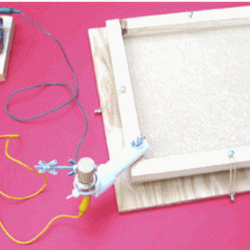Source Institutions
Source Institutions
Add to list Go to activity
Activity link broken? See if it's at the internet archive

This activity guide includes instructions on how to build a "Shake Table" by mounting an eccentric mass (off center) on the shaft of a small dc motor. Learners use this table to simulate the shaking of an earthquake. Learners build structures with wooden blocks, pasta, or a variety of other simple materials and observe how the structures hold up on the Shake Table, including when they adjust the speed of the motor to find the resonant frequency which will topple a particular structure. Other earth-science-related activities, such as liquefaction or seismography, can also be investigated.
- 1 to 2 hours
- 45 to 60 minutes
- Over $20 per group of students
- Ages 11 - 18
- Activity, Lesson/Lesson Plan, Model, Simulation
- English
Quick Guide
Materials List (per group of students)
- 1 piece plywood, 3/8 in or thicker, 12 in x 12 in
- 2 machine screws, 10 - 24 x 2 1/2 in long
- 1 piece masonite, 1/8 in thick, 10 in x 10 in
- 4 wing nuts, 10-24
- 4 pieces of wood, 3/4 in x 3/4 in, 9 1/4 in long
- 2 flat steel washers, 1/4 in
- 8 sheet metal screws, #6 x 5/8 in, pan head, Phillips
- 8 additional sheet metal screws, #6 x 5/8 in, pan head, Phillips (optional)
- wood block, 2 in x 4 in x 3/4 in
- 4 finishing nails, 1.5 in
- 1 potentiometer, 25 ohm
- 3 alligator clip leads
- 4 rubber bands, #16
- electric drill
- 4 plastic film can lids
- 3/16 in drill bit
- 7/64 in drill bit
- 1/16 in drill bit
- 4 marbles
- 1 PVC pipe, 1/2 in, Schedule 40, 3 in long
- 1 PVC elbow, 1/2 in
- screwdriver
- 1 small electric motor, 1.5-3 volts, dc
- hot glue gun
- hot glue sticks
- battery, 1.5 volt, D cell
- 1 cable tie, 7.5 in
- masking tape or clamps
- 1 wooden dowel, 3/4 in diameter x 1 in long
- band saw
- structural building materials (straws, toothpicks, pasta, or bamboo skewers)
- joining materials (small marshmallows, spice drops, paper clips)
- building blocks, Lego bricks, Lincoln Logs
- narrow, tall objects (marker pens, paper towel tubes)
- small container of wet sand
- strip of paper
- roller-ball or fiber-tip pen
- beads, ball bearings, small pieces of PVC, etc. to simulate molecular motion (optional)
Subjects
-
Earth and Space Science
-
Earth Processes
- Earthquakes
-
Earth Structure
- Rocks and Minerals
-
Earth Processes
-
Physical Sciences
-
Electricity and Magnetism
- Electric Motors
-
Vibration and Waves
- Wave Motion
- Motion and Forces
-
Electricity and Magnetism
-
The Nature of Science
-
The Scientific Process
- Conducting Investigations
-
The Scientific Process
-
The Nature of Technology
-
The Design Process
- Problem Solving
-
The Design Process
Informal Categories
- Model Building
- Nature and Environment
Audience
To use this activity, learners need to:
- see
- touch
Learning styles supported:
- Involves hands-on or lab activities
Other
This resource is part of:
Access Rights:
- Free access
By:
- Rathjen, Don
Rights:
- All rights reserved, Exploratorium, 2004
